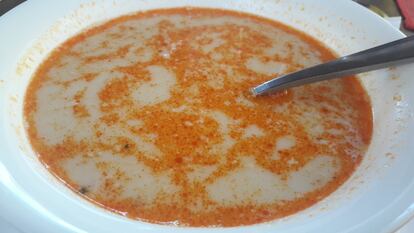The Bulgarian soup that cures a hangover
Served in restaurants across the country, ‘shkembe chorba’ contains milk and tripe and is dressed with salt, garlic, wine vinegar and chili


Bulgaria may be the least-known country in the European Union. A former member of the Eastern Bloc that headed the extinct USSR, for many, its name only recalls Hristo Stoichkov, the former soccer player who played for FC Barcelona in the 1990s. But the Balkan country is much more than kicking balls and a former Communist regime. It has an enormous cultural heritage, including sites such as the Rila monastery, the city of Plovdiv and the capital of Sofia. Its culinary richness is also notable, from tarator soup made with yogurt and cucumber, to the strong fruit liquor rakia, sausages like bireni and keparche and lyutenitsa, a pepper paste eaten on a slice of bread or alongside a plate of meat. And, of course, there is shkembe chorba (шкембе чорба).
The dish’s two main ingredients —pieces of calf stomach and fresh milk— may seem difficult to combine in a single recipe. But it is possible, and the combination is known in Bulgaria as a hangover cure, alongside the local specialties of fermented cabbage juice and ayrán, a drink made with water, yogurt and salt. The dish also includes oil, butter, paprika, salt, garlic, wine vinegar and chili.
The result is a steaming soup, slightly gelatinous, whose white surface is tinged with red from the paprika. The tripe, always cut into tiny pieces after being cooked for hours, gives the dish its nutritional heft. But before taking a bite, it is recommended to dress the soup with the two dressings that accompany it: the first, a mixture of garlic and vinegar; the second, a chili-based dressing. Without them, the soup may taste rather bland. But with them, it wins over many. Yes, it does affect your breath: traditionally, places that served the dish offered diners clove seeds to chew in order to eliminate the undesirable side effects.
Bulgaria’s most famous chef, the television star Ivan Zvezdev, called shkembe chorba the country’s favorite soup. It has similarities with dishes from other countries, also cooked with calf stomach. In Serbia and Bosnia and Herzegovina, its analog is shkembi; in Hungary, pacal leves and in Romania ciorbă de burtă. The Turkish İşkembe çorbası is thought to be the origin of them all: let’s not forget that Sofia was part of the Ottoman Empire until 1878. Since then, the dish has had a peculiar social evolution in Bulgaria. It was once considered a dish of the lowest classes, as tripe was cheaper than heart and liver. In the 1930s, wealthy Bulgarians began eating it as a cure after a night of drinking. During the Communist regime, the unpretentious places that served it, known as shkembedzhiynitsi, became places of encounter for opposition artists and intellectuals, who gave the places and the establishments “a certain romantic and rebellious aura,” as the historian Albena Shkodrova, author of the book Communist Gourmet, wrote in an article.
Today, with Bulgaria as part of the EU since 2007, it’s not hard to find shkembe chorba listed as one more plate on a restaurant menu. You can even buy clean, semi-prepared tripe in supermarkets —frozen or canned— to make the soup at home in five minutes. Its reputation as a dish for men —given the presence of garlic— has changed. What hasn’t changed is its reputation as a morning-after cure, though you don’t have to suffer a hangover to enjoy it.
Sign up for our weekly newsletter to get more English-language news coverage from EL PAÍS USA Edition
Tu suscripción se está usando en otro dispositivo
¿Quieres añadir otro usuario a tu suscripción?
Si continúas leyendo en este dispositivo, no se podrá leer en el otro.
FlechaTu suscripción se está usando en otro dispositivo y solo puedes acceder a EL PAÍS desde un dispositivo a la vez.
Si quieres compartir tu cuenta, cambia tu suscripción a la modalidad Premium, así podrás añadir otro usuario. Cada uno accederá con su propia cuenta de email, lo que os permitirá personalizar vuestra experiencia en EL PAÍS.
¿Tienes una suscripción de empresa? Accede aquí para contratar más cuentas.
En el caso de no saber quién está usando tu cuenta, te recomendamos cambiar tu contraseña aquí.
Si decides continuar compartiendo tu cuenta, este mensaje se mostrará en tu dispositivo y en el de la otra persona que está usando tu cuenta de forma indefinida, afectando a tu experiencia de lectura. Puedes consultar aquí los términos y condiciones de la suscripción digital.
More information
Archived In
Últimas noticias
Most viewed
- Reinhard Genzel, Nobel laureate in physics: ‘One-minute videos will never give you the truth’
- Oona Chaplin: ‘I told James Cameron that I was living in a treehouse and starting a permaculture project with a friend’
- Pablo Escobar’s hippos: A serious environmental problem, 40 years on
- Charles Dubouloz, mountaineering star, retires at 36 with a farewell tour inspired by Walter Bonatti
- Why we lost the habit of sleeping in two segments and how that changed our sense of time










































